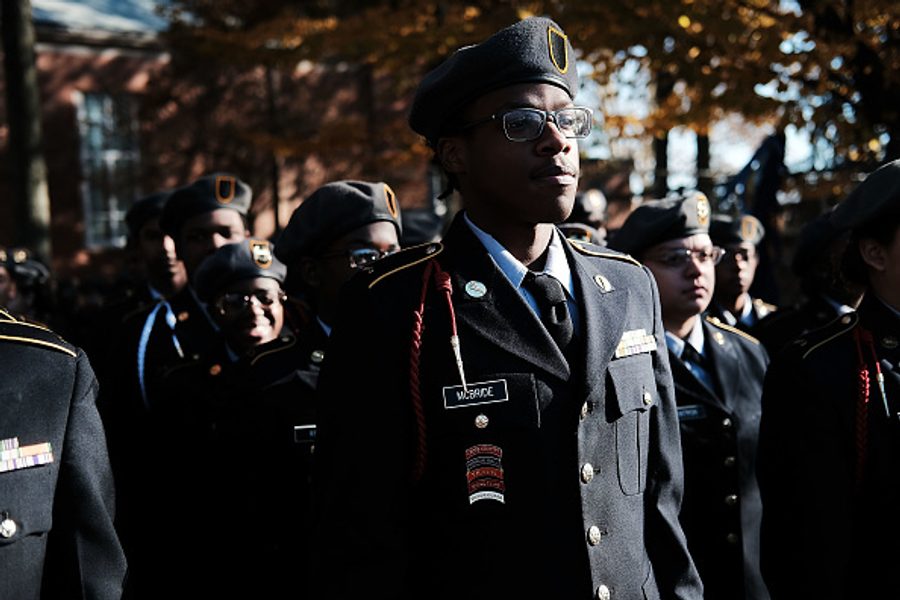From Student Debtor to Soldier
How the student loan debt crisis forces low-income students of color into the military.
Anna Attie

When James Gardner got injured playing basketball as a DePaul University freshman, he lost his financial aid package and was dropped from his classes. To stay in school, he took out a $10,000 loan.
Soon, Gardner (a pseudonym requested in fear of reprisal) and his family realized they couldn’t afford the university. Instead, he transferred to a public university outside Chicago and enrolled in the Reserve Officer Training Corps (ROTC) of the Air Force. The military paid for his entire college education — on the condition he serve at least four years after graduation.
Gardner is a member of the Democratic Socialists of America (DSA) and says the military is geared toward “resource extraction and resource allocation.” When DSA colleagues learn about his military background, he says there is a “little bit of a gasp.”
“Would I be in the same predicament,” he wonders, “if college and university were tuition-free? Would I have gone through ROTC? I don’t know.”
Gardner’s situation isn’t unique. Americans owe more than $1.67 trillion in student debt, and the cost of college has increased by more than 25% in the past 10 years. According to a 2017 poll by the Department of Defense, paying for education is the top reason young people consider enlisting. In 2019, the Army credited the student debt crisis with helping it surpass its recruitment goals.
“One of the national crises right now is student loans,” Maj. Gen. Frank Muth, head of Army Recruiting Command, said in 2019. While wars in the Middle East were “not really part of the discussion” during his visits to recruiting stations, he said educational benefits were a strong selling point.
The pull of the military has even withstood Covid-19. Though the pandemic has hindered military enrollment because of the lack of in-person sites, Army recruiters are confident they will meet their recruitment and retention goals, and are making student loan payments central to their efforts. Military benefits include ROTC scholarships, loan repayment programs and the GI Bill.
“I’m guessing about 60% of people wouldn’t join the military if they already had their education paid for,” says Matt Drennan, who just began his first year at the Virginia Military Institute. While college money wasn’t Drennan’s only motivator, he says joining the military will help him “not be a burden” on his parents. His father still has his own student debt to pay.
The student debt crisis disproportionately affects people of color, with Black women owing more than any other demographic. Not coincidentally, Black women are heavily overrepresented in the military. In 2018, Black women accounted for almost 30% of all active-duty women, despite comprising only 13.7% of U.S. women.
Gardner acknowledges that many Black families, like his own, have a military legacy. But overall, he says, the answer to why Black people are overrepresented in the military is “the same reason why anyone else goes: It’s the economics.”
Children are often pushed toward the military long before they consider college applications or graduate high school. In fact, 2001’s No Child Left Behind Act requires public schools to give military recruiters unfettered access to students. Recruiters then disproportionately target schools in poor and working-class neighborhoods.
Nika Lofton, now a junior at the University of Chicago, graduated in 2018 from Central High School in Macon, Ga. She remembers military recruiters as early as middle school. “Any time I ever heard anyone talk about [why they were joining the military], it was … free college,” Lofton says, not “being really passionate about going to the military.”
At Lofton’s school, military involvement fell along color lines with few (if any) white students joining the Army’s Junior ROTC program for teens. Central High School is almost 90% Black and 99% of students are from poor families.
Junior ROTC programs are especially common in poor, majority-minority school districts. And they have been expanding for decades. The Army Junior ROTC website boasts that around 40% of all the programs are in “inner city schools, serving a student population of 50% minorities.”
“These students are seen as disposable and easy to recruit,” says Asha Edwards, a University of Illinois sophomore who co-founded a chapter of the anti-war organization Dissenters. She says anti-military organizers must introduce alternatives to the military and dissuade youth involvement with ROTC programs, which “prey on poor Black students.”
“If we divest from the Pentagon and the war industry,” Edwards says, “we could afford free college.”

I hope you found this article important. Before you leave, I want to ask you to consider supporting our work with a donation. In These Times needs readers like you to help sustain our mission. We don’t depend on—or want—corporate advertising or deep-pocketed billionaires to fund our journalism. We’re supported by you, the reader, so we can focus on covering the issues that matter most to the progressive movement without fear or compromise.
Our work isn’t hidden behind a paywall because of people like you who support our journalism. We want to keep it that way. If you value the work we do and the movements we cover, please consider donating to In These Times.
Anna Attie is a writer, community organizer, former In These Times intern and a University of Chicago graduate.





